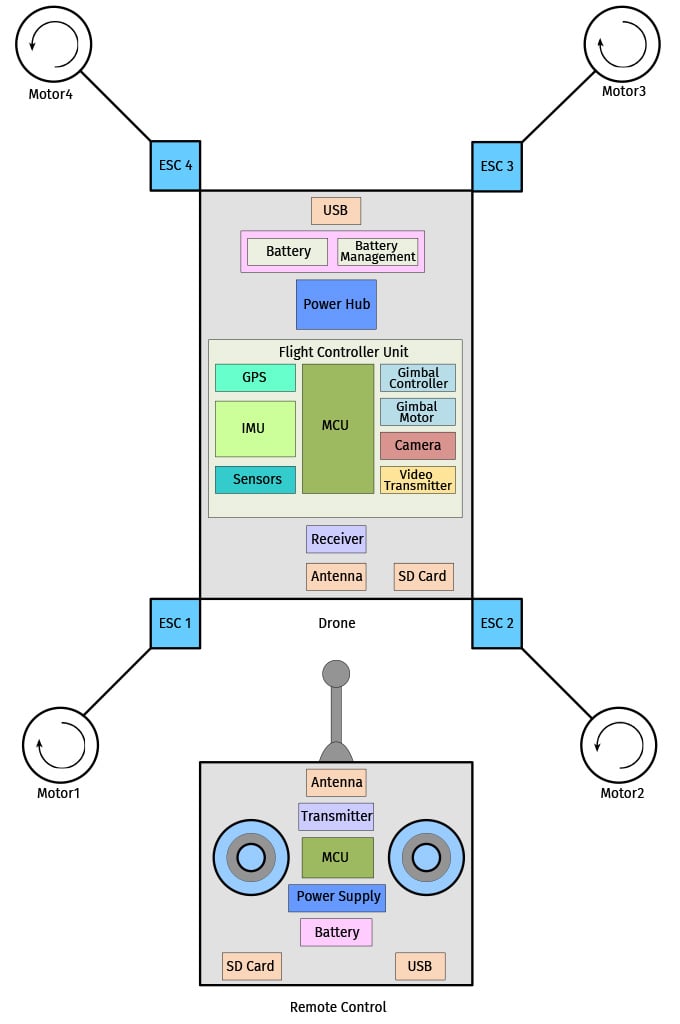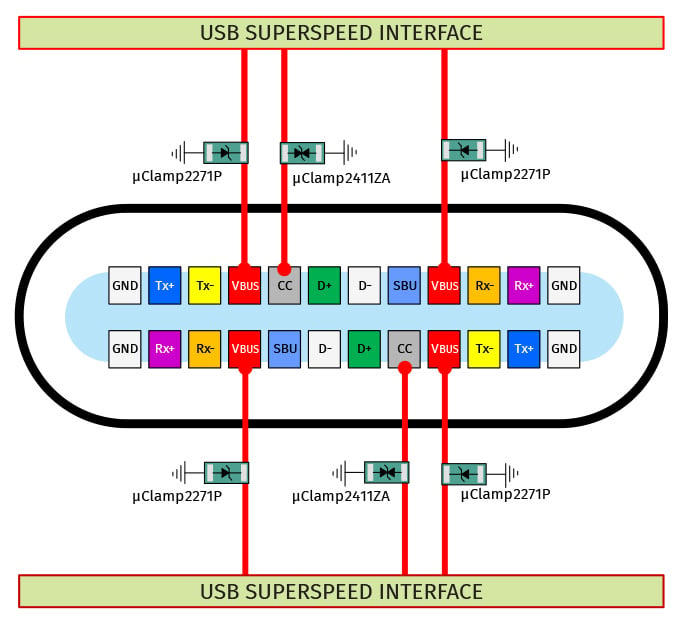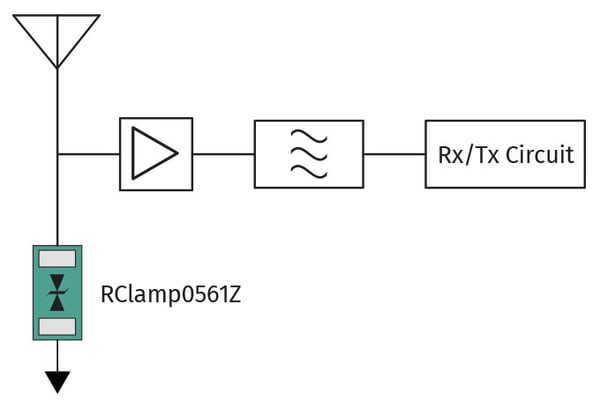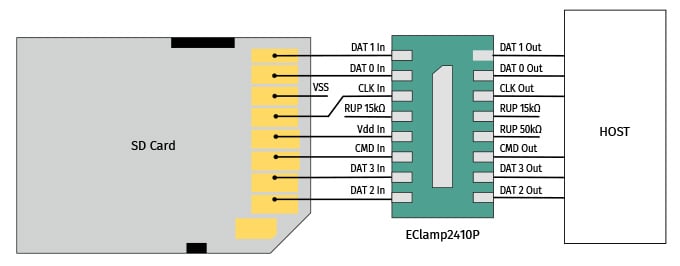ESD保護でドローンの故障を防ぐ
2020年9月、3,051機の無人機(UAV)、またはドローンを使った壮大な光のショーが流行し、UAVの同時対空機数の世界記録を更新しました。ドローンは劇的なライトショーの提供だけでなく、さまざまな有用な用途にも進出しつつあります。工業生産検査、農作物検査、建設現場検査、捜索救助活動、不動産撮影、森林火災管理などは、ドローンが活用され、人類に貴重なサービスを提供している例です。

Operating a Drone
Operating a drone is not much different than playing a video game using a remote control. For example, if your drone has a camera and you would like to take some aerial shots, you can provide the appropriate commands via your drone’s remote. Based on your commands, the drone’s camera will take the pictures. It transmits pictures or videos and can also record the same if instructed. After the assigned task is complete, the drone will return back safely to its designated landing spot. Depending on the type and capability of the drone, instructions can also be provided either from a mobile phone app or from a computer application that can interface with the drone. Sounds simple, right? While the operation might be simple, the technology that makes it all possible is quite exhaustive. In addition, care is taken to minimize the size and weight of the drone while extending the flight time and battery life.
Architecture of a Drone
Most drones are equipped with four motors, which is why they are often called quadcopters. An electronic speed controller (ESC) is used to control the action of each motor. The brain or main part of a drone is the flight controller unit. In commercial or high-end drones, the flight controller is equipped with a GPS for autopilot monitoring. The remote-control device consists of a radio transmitter which interfaces with the drone’s radio receiver. A flight controller generally receives the commands from the radio receiver, interacts with
proximity sensors to avoid obstacles and interfaces with the in-built GPS for geo positioning. The flight controller sends signal to the ESCs which in turn drives the individual motors for coordinating the drone’s movement. To measure the position of the drone with respect to the ground level an inertial measurement unit (IMU) with accelerometers and gyroscopes is used by the flight controller. Figure 1 shows the architecture of a drone along with its remote control.
Almost all drones are equipped with cameras. To take jitter-free photos and videos while the drone is in flight, it uses a device called a gimbal. The gimbal makes sure that the camera remains in place even when the drone is in motion. Some drones come with remote controls furnished with a display. Others provide the option to pair and mount a smart phone or a tablet to control and monitor the drones flight and action. Drones generally use lithium polymer batteries as they have higher energy density, lighter weight and smaller form factor. A large number of drones and their remote-control batteries are charged via USB Type-C charging ports. The power hub or the power distribution board takes power from the battery and sends it to the ESCs for powering the motors. The power hub also provides power to the flight controller unit, gimbal controller, camera, sensors, and other components that need power.

Figure 1. Architecture of a drone and its remote control © Semtech Corporation
ESD Protection of Drone Ports and Interfaces
Drones and their remote controls have several ports and interfaces like USB Type-C for charging the batteries, memory card for saving the photos/videos, antennas for communication, GPS for autopilot system, and sensors to detect obstacles. With so many communication and data ports, drones are particularly prone to damage from electrostatic discharge (ESD) events. ESD is the rapid flow of static charge from one object with higher charge to an object with lower charge. So, when an object with high charge comes in contact with another object with low charge, the charge will flow from the high charge object to the one with low charge. This transfer of charges (electrons) may lead to an ESD event reaching up to thousands of volts. This event can potentially damage the intricate internal circuitry of the drone thereby causing it to fail, which in turn may also lead to serious injury or property damage. Hence, ESD protection is not just important for drones, it is vital.
Protecting USB Type-C Interface
Now-a-days, a large number of drones and remote controls incorporate USB-Type C interfaces for charging. A USB Type-C interface can deliver up to 100W of power, 5 A of current and 20 V of voltage utilizing USB power delivery (USB PD). With the USB PD feature, devices can be charged at a much faster rate. This faster charging feature of USB Type-C has made it very popular for charging the drones. If USB PD is not required, the VBUS can support 5V at 3A, delivering 15W of power.
Figure 2 details the USB Type C pin configuration. As highlighted in the figure, protection from ESD is required for the VBUS and the CC pins. There are two CC pins, one is used for orientation detection and the other one for initiating power delivery. The VBUS pin is next to the CC pin. If there is a voltage surge in the VBUS pin, which can reach up to 20V, the CC pins will also be exposed to this entire voltage in case of a short circuit condition. Protecting the VBUS pin requires a transient voltage suppressor (TVS) diode with more than 20V of operating voltage, a fast response time and low clamp voltage. In addition, degradation of device performance is not desirable while protecting the VBUS pin. Satisfying all these criteria, Semtech’s µClamp®2271P is perfectly suited to safeguard the VBUS pin. The µClamp2271P has a working voltage of 22V with peak pulse current of 25A.
A TVS diode with a minimum 20V breakdown is required to protect the CC pins. Semtech’s µClamp2411ZA with the capacity of withstanding high ESD with voltages ranging from ±20kV (Air), and ±17kV (Contact) is best suited for protecting the CC pins. Maintaining an operating voltage of 24V, µClamp2411ZA is a bi-directional TVS diode with a low dynamic resistance of 1Ω. It comes in an ultra-small 0201 package.
Apart from the VBUS and CC pins, for ESD protection of all the other pins of a USB Type C interface, please read my blog on USB Type-C protection.

Figure 2. ESD protection of an USB PD interface © Semtech Corporation
Protecting Drone Antennas
Drones communicate with their remotes via radio frequencies, which always need an antenna to transmit and receive radio signals. Drones typically use 900MHz to 2.4GHz transmission signal for radio and GPS communication. A bidirectional ESD protection device with an ultra-low junction capacitance is required to preserve the signal integrity of the antennas at that high frequency range. The peak-to-peak voltage of these signals should also remain stable. Semtech’s RClamp®0561Z provides transient protection as per the specification in IEC 61000-4-2 (ESD) at ±15kV (Air), and ±12kV (Contact). It’s built in a tiny 0.62x0.32x0.30mm package. The typical junction capacitance of RClamp0561Z is also extremely low, only 0.12pF. Figure 3 shows a typical antenna protection circuit.

Figure 3. ESD protection of a drone antenna © Semtech Corporation
The ultra-low capacitance of RClamp0561Z exhibits minimal effect on the transmission line impedance and very low insertion loss characteristics, 0.8dB loss at 10GHz frequency. This makes it a compelling ESD protection device for drone radio antennas. For other specifications and application areas including GPS, Semtech offers a wide variety of ESD protection diodes as shown in Table 1.

Table 1: Wide range of applicable Semtech parts for protecting drone antennas
Protecting Memory Cards
Drones are primarily used to take pictures and record videos. So, most of the drones come with one or more memory card slots. As there are exposed pins in a memory card slot, the memory card is extremely susceptible to ESD charge transfer. Semtech’s EClamp®2410P is a combination of EMI filter and line termination device with integrated TVS diode that can protect the memory card from an ESD event. Figure 4 below outlines a typical protection solution for a memory card. EClamp2410P is comprised of series and pull up resistors required on the SD/µSD interface. Each line also includes TVS diodes for ESD protection. Each data line as shown in Figure 4 has a typical capacitance of 12pF. An additional TVS diode connection is included for protection of the voltage bus. TVS diodes provide effective suppression of ESD voltages of ±15kV (air) and ±8kV (contact) as per IEC 61000-4-2 guidelines. EClamp2410P comes in a 16-pin DFN (4.0 x 1.6 x 0.58mm) package. The flow-through package design of this device simplifies the PCB layout.

Figure 4. ESD protection of a drone’s memory card © Semtech Corporation
The popularity and the use of drones are on the rise. It is crucial that the drones are adequately protected from all ESD threats. Semtech’s wide range of trusted TVS products shield many of the world’s most popular drone brands. Its highly efficient TVS products protect all types of drone ports and interfaces including USB PD, antennas and memory card interface. You can enjoy problem free, fault free use of drones by protecting its ports and interfaces with Semtech TVS products, while enhancing their dependability and lifetime.
Explore Circuit Protection solutions on our website.
Semtech®, the Semtech logo, EClamp®, RClamp®, and μClamp® are registered trademarks or service marks of Semtech Corporation or its affiliates. Other product or service names mentioned herein may be the trademarks of their respective owners.

